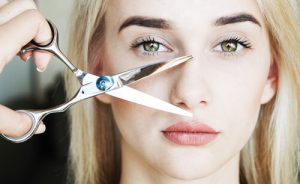Preparing to get a rhinoplasty, or “nose job,” can be intimidating. Nevertheless, with the proper information and preparation, you will be equipped to take the necessary steps towards your desired outcome. So, how long is a nose job recovery? Here is an easy-to-follow guide that will assist you in understanding what’s involved in getting a rhinoplasty procedure.
The Benefits of Rhinoplasty
Before you make up your mind, it’s natural to ponder why so many opt for rhinoplasty as their preferred ‘makeover’ procedure. Nose jobs are favoured by both men and women alike due to a multitude of reasons. While some may perceive this operation exclusively from the perspective of aesthetics enhancement, there is much more that can be gained through nose than just appearances alone!
Rhinoplasty can offer numerous advantages to individuals who choose to go through with the procedure. The following are some of the most frequently cited benefits:
- Improving facial proportion and symmetry: Rhinoplasty can be used to modify the shape, size, and angle of your nose, creating a more harmonious balance among all of your facial features.
- Boosting self-esteem: By dealing with any doubts or worries concerning your physical appearance, you can feel more self-assured and less intimidated in social situations.
- Correcting breathing problems: If you have been enduring issues such as difficulty breathing and blocked nasal passage due to injuries or physical irregularities, rhinoplasty can assist in providing a solution. It will improve your airflow and promise an enhanced quality of life by correcting the structural difficulties causing this havoc.
- Treating medical conditions: For certain medical conditions, rhinoplasty is essential for treating respiratory issues like sleep apnoea due to nose structure obstruction.
- Altering physical imperfections: Struggling with the shape and size of your nose? If you feel unsatisfied with any physical imperfections, rhinoplasty can offer a lasting resolution to these aesthetic issues.
Preparation
 If you are interested in rhinoplasty, the first step is scheduling an appointment with a doctor. During your consultation, they will review your medical history and assess your nose to decide if you can safely undergo . Beforehand, make sure that you know why you want it done, what kind of results are desired, as well as any potential risks associated with it so that all questions may be answered thoroughly by both patient and physician alike. To ensure a successful , your doctor will give you instructions on how to best prepare. This may include quitting smoking or eliminating certain medications from your regimen. Additionally, the doctor will take photos that are used as reference material in creating a plan tailored to you.
If you are interested in rhinoplasty, the first step is scheduling an appointment with a doctor. During your consultation, they will review your medical history and assess your nose to decide if you can safely undergo . Beforehand, make sure that you know why you want it done, what kind of results are desired, as well as any potential risks associated with it so that all questions may be answered thoroughly by both patient and physician alike. To ensure a successful , your doctor will give you instructions on how to best prepare. This may include quitting smoking or eliminating certain medications from your regimen. Additionally, the doctor will take photos that are used as reference material in creating a plan tailored to you.
Anaesthesia
Rhinoplasty is usually done via general anaesthesia as an outpatient procedure, so you won’t have to spend the night in a hospital. Prior to being taken into , your doctor will give you preoperative instructions on how best to prepare and any pain relief medication they may recommend. Your doctor might also draw markings on your face beforehand for accuracy during the operation.
Operation Procedure
To reshape and reposition the underlying facial structure–including cartilage, bones, soft tissues etc.–incisions are made along either side of the nose and its bridge (columnar structure). Depending on whether an open or closed technique is being used for a particular procedure, these incisions may involve more skin removal than others. By accessing this area through making incisions, grafts can be added as needed, while any excess tissue will then be removed.
The skilled doctor will reshape and reposition cartilage or add grafts to create the ideal effect, whether that involves deepening/widening nostrils, bridging ridges/depressions and more. Splints are then inserted into each nostril for healing support and to counterbalance any swelling. The incisions are closed using fine stitches, which can either dissolve on their own or be removed after a few weeks, depending on the type.
Recovery phase
After undergoing , patients are immediately taken to the recovery room, where medical professionals monitor their vital signs, such as blood pressure, until they reach healthy levels. Though bruising and redness are common post-, they should subside within six days with proper care according to medical instructions, like using cold compresses overnight.
What to expect during the recovery period
After rhinoplasty , it usually takes two weeks for the swelling to settle down. To ensure quick and infection-free recuperation, you must avoid blowing your nose and touching any scabs during this time. Doing otherwise could slow the healing process and increase the risk of developing an infection.
It would also be advisable not to wear glasses/sunglasses until the tissues fully heal (up to around six months). Additionally, postoperative visits must be scheduled with your doctor every few months so that they may monitor any scarring-related issues, such as excessive blood vessel growth in certain areas, etc.
It’s essential to comprehend that the swelling may take up to a year before it completely decreases and your finalised new nose is revealed. You’ll notice a steady transition in appearance over the initial weeks as the tissue mends and puffiness continues on its course of reduction. If you’re inquiring when it’s possible for you to return back to work, then this varies by person; most people are capable of going back usually within three weeks from light duties. However, those with more laborious jobs might need an extended time frame before being granted permission to work again.
Tips for Facilitating the Rhinoplasty Recovery Time
Following these tips throughout the recovery period will help facilitate your recovery and keep it on track.
Follow Your Doctor’s Instructions
 Despite all the information you may find online regarding your recovery period, there is no more valuable advice than to adhere to what your facial cosmetic doctor specifically recommends. Since they are familiar with the procedure and your individual case history, they can most effectively guide you through the process, accordingly prescribing any necessary medications. Therefore it is essential that you book follow-up consultations regularly for an effective and safe transition into healing.
Despite all the information you may find online regarding your recovery period, there is no more valuable advice than to adhere to what your facial cosmetic doctor specifically recommends. Since they are familiar with the procedure and your individual case history, they can most effectively guide you through the process, accordingly prescribing any necessary medications. Therefore it is essential that you book follow-up consultations regularly for an effective and safe transition into healing.
Watch out for Certain Side Effects
Soon after your nose reshaping, you might witness a few minor side effects, such as redness or slight bruising around the eyes. These should reduce within two weeks; however, if they continue, then contact your facial cosmetic doctor right away. You may feel some discomfort initially, but this will lessen during the following days and shouldn’t interfere with normal activities. If you are feeling excessive pain that is disrupting your daily routine, make sure to tell your doctor immediately.
Keep Your Head Elevated
In the early stages of recovery, it is vital to keep your head in an upright position while sleeping as much as possible. This prevents any further harm and encourages circulation throughout your body. For at least six weeks after , you must sleep with a straight back, attempting not to roll onto either side or face down since this could damage the healing process of your nose.
Reduce Swelling with a Cold Compress
During the first 2-3 days following , you should apply a cold compress to your face to help reduce the swelling and redness. Be careful not to press the cold compress directly to your nose, as this will put it out of place. Apply it to your cheeks instead, and avoid touching your nose altogether.
Maintain a Healthy Diet
Eating healthy is always critical, particularly when you are recovering from an invasive procedure. Make sure to consume foods that boast a range of vitamins, including C and D, as well as protein and calcium, which all serve to reduce swelling in addition to helping with the healing process. Be sure your diet also has anti-inflammatory properties for optimum recovery results!
Avoid Blowing Your Nose
 This may seem pretty obvious, but it bears repeating. Avoid blowing your nose at all costs for the first six weeks or so following your rhinoplasty procedure. During this time, you’re going to experience a lot of congestion due to blockages in your nasal passage while your nose is healing. Do not blow your nose. Instead, talk to your doctor about using saline-based nasal sprays to help clear up the congestion and mucus buildup. On that note, you should also avoid any direct physical contact with your nose whatsoever for the first six weeks, and this includes wearing sunglasses, face masks, and even scratching an itch. Even the smallest point of contact can cause injury.
This may seem pretty obvious, but it bears repeating. Avoid blowing your nose at all costs for the first six weeks or so following your rhinoplasty procedure. During this time, you’re going to experience a lot of congestion due to blockages in your nasal passage while your nose is healing. Do not blow your nose. Instead, talk to your doctor about using saline-based nasal sprays to help clear up the congestion and mucus buildup. On that note, you should also avoid any direct physical contact with your nose whatsoever for the first six weeks, and this includes wearing sunglasses, face masks, and even scratching an itch. Even the smallest point of contact can cause injury.
Rhinoplasty is a detailed process involving both preoperative assessments and postoperative care, so anyone considering it must do their research thoroughly beforehand in order to achieve successful results without complications down the line!
References:
https://healthcare.utah.edu/the-scope/shows.php?shows=0_eb0eflgn
https://myhealth.alberta.ca/Health/aftercareinformation/pages/conditions.aspx?hwid=zc2691
https://my.clevelandclinic.org/health/treatments/11011-rhinoplasty
https://www.allure.com/story/rhinoplasty-everything-you-need-to-know
https://www.cosmetic.org/news/blog/what-to-expect-during-your-rhinoplasty-recovery
https://www.webmd.com/beauty/cosmetic-procedures-nose-job-rhinoplasty

